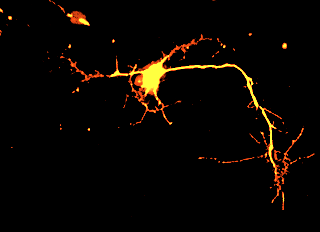


The metamorphic development of holometabolous insects involves large-scale
reorganizations of all tissues. Developmental studies demonstrate that the principle
topological organization of the meal beetles mid-brain is not much affected by
the drastic reorganizations during metamorphosis. The larval brain already shows
most of the essential characteristics of the later adult one. We focussed our
study to the development of specific neuropil regions as the so called central
complex or the antennal lobe.
For an analysis of the neuroanatomical development
we use classical silver impregnations, immunohistochemistry, specific injection
techniques and ultramicroscopic analysis.
The characterization of identified
neurons in the brain throughout development allows the description of morphological
changes after application of neurotoxins in an in vivo assay.
Effect
of pyrethroids on neurons from beetle and chicken  Pyrethroids
are potent insecticides which are widely used in agriculture, disease vector control
or in hosehold products. Many have a low toxicity against mammals, and a high
toxicity against most arthropods.
Pyrethroids
are potent insecticides which are widely used in agriculture, disease vector control
or in hosehold products. Many have a low toxicity against mammals, and a high
toxicity against most arthropods.
To expand knowledge about the influence of the pyrethroids on neuronal development the metamorphic remodelling of the beetle brain is used as a modell for studying the formation and plasticity of nervous tissue.
For an analysis of the effect of pyrethroids on developing neuronal
cells in vitro, we use cell cultures of embryonal chicken neurons and brain
neurons from larval, prepupal and pupal stages of the beetle Tenebrio molitor.
Pattern formation of neurons in vitro
 Brain neurons of embryonal chicken show a pattern formation in the cell culture
by reaggregation of somata and fasciculation of neurites. After 5 days in culture
those cells establish three diamensional clusters with internal differentiation.
Our interest is due to the parameters changing or enhancing this tissue like organization.
Brain neurons of embryonal chicken show a pattern formation in the cell culture
by reaggregation of somata and fasciculation of neurites. After 5 days in culture
those cells establish three diamensional clusters with internal differentiation.
Our interest is due to the parameters changing or enhancing this tissue like organization.